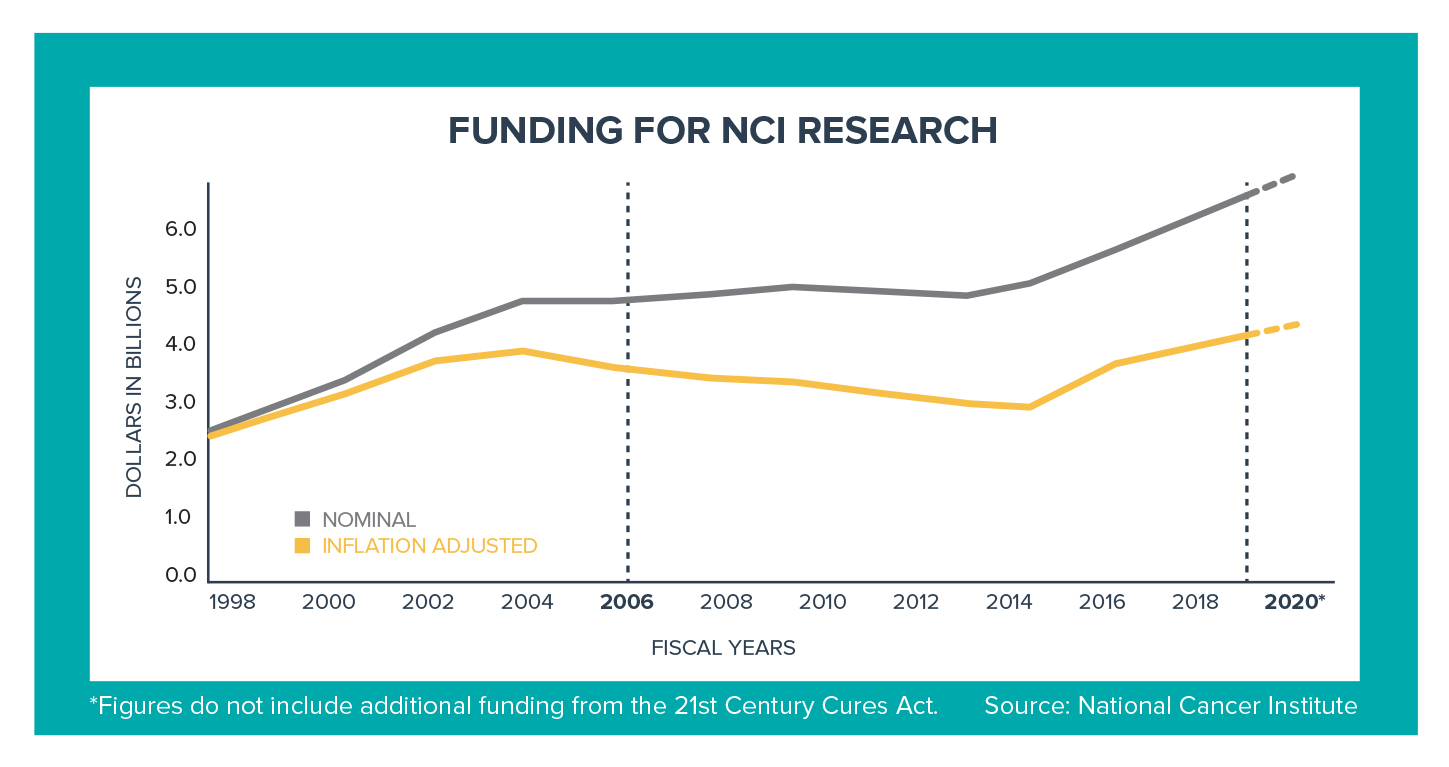
ASCO’s Media Issue Briefs provide succinct overviews and relevant data on major policy issues impacting patients with cancer and the physicians who care for them. These briefs are designed to be especially helpful for journalists, offering background information on key issues across health policy today. Access ASCO’s full collection of Media Issue Briefs.
Issue Overview
The National Institutes of Health (NIH) supports the overwhelming majority of federally funded medical research, and with the National Cancer Institute (NCI), has led to significant advances in cancer prevention, detection, diagnosis, treatment, and quality of life of patients. More than 15.5 million cancer survivors[1] are alive in the United States today, due in no small measure to the nation’s commitment to cancer research.
Federally funded cancer research typically explores clinical issues that pharmaceutical and biotechnology companies are not likely to pursue, such as trials that:
- Evaluate direct comparisons of already-available treatments, multiple drugs, or combinations of different types of treatments;
- Assess screening and prevention strategies;
- Study treatments for rare cancers (which often aren’t profitable for companies);
- Examine strategies for improving the quality of life for patients with cancer and survivors.
As cancer care demand and complexity has increased, federal research funding has failed to keep pace. For much of the past decade, federal funding for medical research has been flat, limiting the ability of scientists to conduct research that advances the screening, prevention, diagnosis, and treatment of cancer.
Current Status of Federal Funding
In September 2018, Congress passed the Fiscal Year 2019 Labor, Health and Human Services Appropriations bill, which provided a $2 billion increase to the NIH, bringing NIH's budget to a total of $39.1 billion and the NCI’s to a total of $6.147 billion. The bill also provided $400 billion (full funding) for the Beau Biden Cancer Initiative. This marks the fourth consecutive annual increase in funding for the NIH and will help the NIH regain much-needed momentum in cancer research following a decade of stagnant funding. However, despite increases, NCI is still only able to fund a small fraction of new research proposals (12% in 2017 vs. 28% 20 years ago, in 1997)[2]
Key Data Points
Federally Funded Research Has Fueled Cancer Breakthroughs
- Better Prevention of Cancers
- Research supported by the NCI helped establish that human papilloma virus (HPV) is a major cause of cervical cancer and helped develop the technology used to create the first HPV vaccines.[3]
- Earlier, Better Detection Of Cancers
- Lung cancer screening has reduced deaths from lung cancer among participants by 20%.[5]
- Better Ways Of Managing Side Effects
- The first anti-nausea drug cut vomiting episodes in patients undergoing chemotherapy by 70%.[6]
- More Effective Treatments
- Highly effective treatments in many childhood cancers have resulted in increases in cure rates (from 10% to 80% since the 1950s).[7]
- Breast-conserving surgery for breast cancer has enabled women to avoid disfiguring mastectomies.
- Tailored combination treatments have improved survival and reduced side effects for many common cancers.
Communities Nationwide Rely on Federal Research Funding
- NIH funds studies conducted by more than 300,000 researchers at more than 2,500 universities, medical schools, and other research institutions in every state and around the world. [8]
- Research funded by NIH generates $69B in new economic activity across the country and supports 402,816 jobs nationwide (directly and indirectly).[9]
- About 10% of the NIH's budget supports projects conducted by nearly 6,000 scientists in its own laboratories.[10]
“Over the past five decades, our nation's investment in research to better understand, prevent, diagnose, and treat cancer has paid huge dividends. Thanks to funding for the NIH and NCI, millions more Americans are surviving cancer. People are not only living longer, but they're living better, with higher quality of life and fewer side effects. But our work is far from over, and as long as cancer continues to be the life-threatening burden it is today, our nation must continue to prioritize investment in cancer research.” -- Monica M. Bertagnolli, MD, FACS, FASCO, ASCO President 2018 - 2019
For More Information
- ASCO’s publication on how U.S. investment in cancer research saves lives.
- ASCO's Cancer Progress Timeline of major advances in cancer research.
- ASCO in Action offers the latest news and information on this and other cancer policy topics.
- To schedule a media interview with an ASCO spokesperson or oncology expert, please contact mediateam@asco.org.
[1]American Cancer Society: Cancer facts & figures 2018. https://www.cancer.org/content/dam/cancer-org/research/cancer-facts-and-statistics/annual-cancer-facts-and-figures/2018/cancer-facts-and-figures-2018.pdf
[2] NIH, Research Project Success Rates by NIH Institute: https://report.nih.gov/success_rates/Success_ByIC.cfm
[3] National Cancer Institute. Milestones in Cancer Research and Discovery. https://www.cancer.gov/research/progress/250-years-milestones.
[5] National Cancer Institute. Milestones in Cancer Research and Discovery. https://www.cancer.gov/research/progress/250-years-milestones.
[6]Powerful Anti-Nausea Drugs Alleviate Major Side Effect of Cancer Treatment, 1991; Dr. Patricia A. Ganz.
[7] O’Leary M, Krailo M, Anderson JR, Reaman GH. Progress in Childhood Cancer: 50 Years of Research Collaboration, A Report from the Children’s Oncology Group. Seminars in oncology. 2008;35(5):484-493. doi:10.1053/j.seminoncol.2008.07.008.
[8]National Institutes of Health. Budget. https://www.nih.gov/about-nih/what-we-do/budget.
[9] United for Medical Research, NIH’s Role In Sustaining the U.S. Economy | 2018 Update: http://www.unitedformedicalresearch.com/wp-content/uploads/2018/02/NIHs-Role-in-Sustaining-the-U.S.-Economy-2018-Update-FINAL.pdf
[10] National Institutes of Health. Budget. https://www.nih.gov/about-nih/what-we-do/budget











